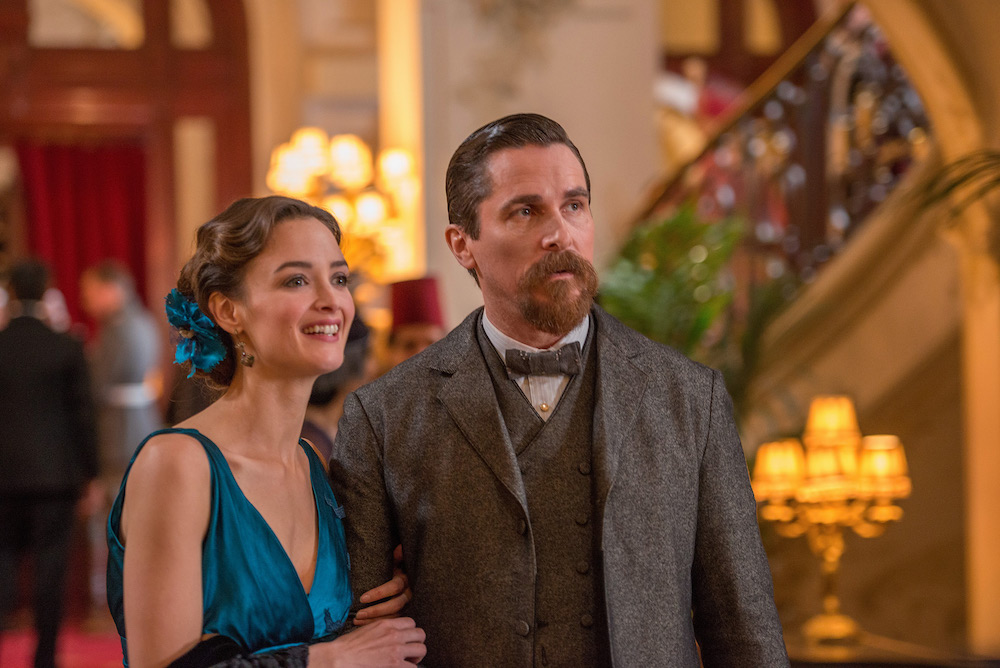
High crimes and entertainment: On the epic art (and hidden dangers) of social impact movies

“O, don’t be shocked when I tell you this story that cannot be told.” – Siamanto
In 1918, a woman named Aurora found herself in the middle of the San Gabriel Mountains. Elaborate sets had been built around her. Thousands of extras were lined up in harrowing scenes of deportation. Naked women lay crucified on crosses. Turkish soldiers in fake mustaches raised their rifles. Aurora was nervous. She was only 18, and she had never been in a movie before. But she knew her part very well. She was so caught up in her role that she fainted, repeatedly, throughout the shoot.
It was not her first time playing this role.
Just a few years earlier, on the other side of the world, Aurora (Arshaluys) Mardiganian had in fact witnessed the slaughter of her family. Like millions of Armenian women in the Ottoman Empire, she had been deported from her home and sent on a death march and forced, again and again, into sexual slavery. After 18 months and 1400 miles, she managed to escape. There was no name in 1915 for what happened to the million and a half Armenians who did not escape. Decades later, reviewing this particular scheme of extermination, a Polish Jewish lawyer named Rafael Lemkin would invent a word to describe it. Aurora had survived the first genocide of modern history.

Reports of that nameless crime terrified and galvanized the American public. In response, a massive effort to rescue Armenian and other Christian orphans took form. Missionaries set sail; fundraisers were held; posters with slogans were printed. Children in Kansas who didn’t eat their peas were told to “remember the starving Armenians.” Near East Relief became the first major international human rights campaign in United States history. It rescued Aurora from the city of Erzerum (Garin) and brought her to New York, where she took out newspaper ads in search of her long lost brother. Within months she was found — but not by him. The people who read her story with the greatest interest and showed up at her door were not related to her at all. They were prospectors of a new and fantastic industry. They knew what could happen if they turned her words into pictures, and made those pictures move. They took her to Hollywood.
They cast her into the nightmare of her own life.
Ravished Armenia, an epic docudrama directed by Oscar Apfel and starring Aurora Mardiganian, was not totally accurate. The naked crucifixion scene, for example. That was only a “civilized” depiction, Aurora later explained, of what the Turks really did to Armenian girls after they were done raping them. “They can’t show such terrible things.” But Ravished Armenia showed a lot, enough to cause a sensation.

The film came out in 1919 and Aurora went on tour to promote it. She waved. She smiled. And then she could smile no more. One night in New York, she fainted, never to be seen in public again. Seven Aurora impersonators appeared in her place at screenings around the country; the show had to go on. Movie tickets in 1919 typically cost twenty-five cents. For Ravished Armenia, they cost ten dollars. Amid censorship controversies and fancy charitable events held around it, the film made today’s equivalent of nearly one billion dollars. Most of it went to good causes, particularly the American Society for Armenian and Syrian Relief.
This was the birth of what is now called social impact entertainment.
But the story of Aurora Mardiganian does not end there. It ends long after our lenses have left her. Aurora was an early casualty of the powerful mechanism that has governed our imaginations with mixed and complicated results for 100 years. She survived the genocide, but she could not survive the movie.
The dangerous relationship of movies and history is as old as Hollywood itself. There were earlier casualties. D.W. Griffith’s Birth of a Nation (1915) famously revived the Ku Klux Klan and launched viewers like President Woodrow Wilson into an emotional frenzy. D.W. Griffith “had achieved what no other known man had achieved,” wrote the critic James Agee. “To watch his work is like being witness to the beginning of melody, or the first conscious use of the lever or the wheel; the emergence, coordination and first eloquence of language; the birth of an art.” The movie language Griffith created was to become the new language of memory. It simplified our memory of the past – the catastrophic past especially – into a spectacle, a big public thing. Griffith had no idea that the crosscuts, close-ups, and grand tracking shots he conceived to express his naïve vision of the American Civil War and Reconstruction to such thrilling effect in 1915 would get so many black Americans lynched.

II
Only 22 minutes of Ravished Armenia, also called Auction of Souls, survive today. As its film reels perished, so too would the public’s memory of the starving Armenians. But Hollywood does not soon forget box-office numbers; and the vast success of Ravished was still fresh in studio minds when Franz Werfel’s novel, The Forty Days of Musa Dagh, became a runaway bestseller in 1933.
Based on the true story of the Armenian resistance at the Mountain of Moses, Werfel’s epic was written as an urgent cautionary tale to his fellow Jews in Eastern Europe. A “burning, bitter, and inspired protest against the Young Turk proclivities of the German Nazi movement,” wrote John Chamberlain of the New York Times. “If Hollywood does not mar and mishandle it,” added Louis Kronenberg, “it should make a magnificent movie.” MGM bought the property and the great Irving Thalberg took charge of the blockbuster adaptation. He chose Rouben Mamoulian to direct, Clark Gable to star. The studio entered a long battle with the Turkish government, which was committed to totally denying the mass crime over which its modern state had been founded.
Turkish ambassador Mehmet Muni Ertegun[1] issued threat after threat to the U.S. State Department and MGM. “To hell with the Turks,” Thalberg replied. “I’m going to make the picture anyway.” The script got sanitized. Then depoliticized. Guilt for the extermination was shifted from the Ottoman government to a single Turkish villain. None of these concessions was enough. When Turkey finally threatened to severely punish its Jewish citizens[2] if the film got made, Louis B. Mayer caved and shut it down.
“We’ve lost our guts,” Irving Thalberg protested. “And when that happens to a studio, you can kiss it good-bye.”
Thalberg had good reason to be furious. In terms of budget, ambition, studio priority, and talent, Forty Days was set to be the Armenian Gone With The Wind. Instead it became the first and decisive triumph of Turkey’s ongoing campaign of genocide denial; a template for how to manipulate the U.S. State Department into censoring its own citizens for a foreign interest; and a crystal model of Hollywood’s oft-repeated incapacity to stand up for its own good under pressure. (The film would’ve made a bundle.) Nobody knows how the world changes if a blockbuster epic about the century’s foundational genocide makes it to the big screen, as planned, in 1936. But one guess is pretty safe.
Before invading Poland, Adolf Hitler would not have been able to calm his skeptical commanders by asking them: “Who, today, remembers the annihilation of the Armenians?”

III
Words are the language of creation. Dante invented Hell as we know her; Tolstoy and Dostoyevsky and Russia are the same. No two people hold the same image of Anna Karenina, however, unless they’ve only seen Keira Knightley lower her girdle for Aaron Taylor-Johnson in the 2012 adaptation. Movies are the language of memory.
World War II is still remembered as captured in the movies: a brave, unified, sometimes tragic fight of good against evil. Apocalypse Now and The Deer Hunter define the memory of the Vietnam War — for those who didn’t fight in it. Without Terry George’s Hotel Rwanda, the genocide of a million Tutsi would remain as neglected as it was in real time. The mass killings of Stalin and Mao tend to recede in the western consciousness, no famous film having been made about them.
Not everyone forgot about the Armenian Genocide as its crimes became a habit of the 20th century; only the world did. The orphan survivors could not forget, hard as some of them tried. Their nightmares were audible to their children, and their children’s children, who inherited the trauma with a responsibility made inescapable by the political victory of denial. Decade after decade, we longed for a movie. Only a major bloody motion picture, it seemed, could unburden us of our memories — could make them a permanent public fact, and set us free.
The longing settled into a question. “When,” Armenians came to wonder, “will we have our Schindler’s List?”
Steven Spielberg’s Schindler’s List was a tremendous achievement for Holocaust awareness because it made its non-Jewish viewers feel like heroes, just for watching. For some survivors, it brought catharsis. But that feeling was far from unanimous. Heroism was not exactly the most important thing about the Holocaust. “The Holocaust is about six million people who get killed,” Stanley Kubrick reflected. “Schindler’s List is about 600 who don’t.” Kubrick abandoned his own Holocaust film project, finding it impossible to do justice to such an event in movie form. Six protagonists are a lot for one movie, after all — let alone six million. Fortunately, public knowledge of the Holocaust has been firm enough to allow filmmakers to explore its myriad themes one by one, from unbearable loss (Sidney Lumet’s The Pawnbroker) to the eternal Jewish condition (Roman Polanski’s The Pianist) to the sheer power of real survivor testimony (Claude Lanzmann’s Shoah), without having to tell the whole story from scratch.

This was a liberty not available to Atom Egoyan when he got the chance, in 2001, to make a film about the fate of his ancestors.
Egoyan had been sitting on a script for years. It told the story of the painter Vostanik Manoug Adoian, who survived the liquidation of Lake Van as a young boy, watched his mother starve to death, made it to America and changed his name to Arshile Gorky. But there was a problem with filming this story now. Violent movies are entertaining because we enjoy the thrill (or pity) of watching people get killed. To make a violent period drama in 2001, eight decades after the Armenian Genocide was last depicted on screen for a wide audience[3], struck Egoyan the same way Schindler’s List struck Holocaust survivor and Nobel Laureate Imre Kertesz — as an exercise in kitsch. Denial had become the bigger story by this time (and the equal crime). So Egoyan set Ararat in the present day, in his hometown of Toronto, where the production of an epic genocide film sets an array of characters on a confrontation course with memory. The script about Gorky’s life became the movie within Ararat, and the real movie became an intricate carpet of storylines, each a metaphor of what happened to the Armenians in 1915.
Ararat made a lot of Armenians antsy. They were not in the mood for intricate metaphors. They sought one simple feeling — recognition — in the form of a big, loud, Technicolor bang the world could not dismiss, ignore, equivocate, silence, forget, or doom with diplomacy. They wanted blood and guts and Brad Pitt. They wanted an Armenian Schindler’s List. That was not Egoyan’s vision. However, Ararat looms. It has aged well. While every one of its threads does not conclude with harmony, Egoyan’s mountain of work presents a vital investigation into the meaning of the past. Ararat accomplished what no “successful” film can. It identified the Armenian Genocide as something much deeper and more significant than a popcorn sob story.
IV
When it comes to watching movies, expectation, not perception, is reality. To those expecting the ultimate cinematic verdict on Scientology and cults, Paul Thomas Anderson’s The Master was a letdown. To those looking for a good drama, it’s superb. Nicole Kidman won an Oscar for The Hours, but her performance probably failed to stir any poor moviegoer who camped out at the box office in the hopes of an uplifting musical about cuckoo clocks. For most target audiences, expectations are simple to manage. The right title, poster, and trailer usually do the trick.
But that is not the case for all audiences.
In 2014, director Fatih Akin released The Cut, a “western” set in 1915 about an Armenian villager who survives his death march and searches the world for his daughters, to a soundtrack of modern electric chords. Armenian viewers didn’t quite take. The film seemed to have a disembodied air — almost as if its director (and star) was too viscerally detached from the tragedy he was trying to tell. Akin, indeed, is a German of Turkish descent, which means his production was an immensely courageous undertaking not conceivable from a man who is even slightly detached. There had to be a different explanation. In a Q&A following a Berlin screening, Akin provided it. The film, he said, was a communication to his father — and the many other Turks like his father who know something happened in 1915 but are too blinded by pride and propaganda to accept what it really was. In light of its true target, The Cut’s oddly passive tone makes sense.
It is easy to see how 100 years of silence and denial can create expectations too massive for any one movie to satisfy. But impossible expectations are only half the issue here. For modern Armenian audiences, perception is not even possible. Most Armenians cannot view Armenian subject matter with their own eyes. The eyes of their grandmother, their cousin, their Jewish neighbor, their Filipino real estate agent, the president, Lebron James — these are the eyes they watch with, wondering how each frame makes their story look to other people.[4] Their private experience comes last, if at all.
What is this ghostly condition? It is something like the condition of the actor. And to our minds, it begins to suggest what Henry James once called the figure in the carpet of modern life in the diaspora.
This is the premise of our feature film 1915 — a psychological mystery set in the Los Angeles Theatre in April 2015, the date also of its release — which we made in pursuit of a fundamental question: how can something that happened so long ago and so far away continue to matter in the present day to the point of life or death? In our story, a cast of strangely selected actors has one chance to perform a controversial play set in 1915. The controversy comes from the play’s climactic scene: An Armenian woman must decide between dying with her children or running off with a Turkish gendarme.
It is a tragic decision that nobody wants to see — not the Armenian actress who must perform it, not her husband who wrote it, not the thousands of Armenians marching outside the theater to commemorate the 100th anniversary of the crime (in the movie and real life), not the Turkish deniers trying to sabotage the production (in the movie and real life), not the directors who wrote the movie in which this is all happening (us), and certainly not most of the Armenians who watch the movie hoping that finally, after 100 years, their burning memories may rest in peace. A number of these viewers confronted us in multiplex lobbies to ask: Why?
Our answer: Because 1915 does not end where it ends.

V
Nearly a century after Ravished, we finally have our big Armenian Genocide movie. Kirk Kerkorian funded the $100 million budget of The Promise, the kind of epic that in his four stints as owner of MGM he could not convince his studio heads to make. Like Ravished, every dollar of the proceeds will go to human rights and other charitable organizations. Starring Christian Bale and Oscar Isaac, directed by Terry George, from a script he wrote with Robin Swicord, The Promise recalls the golden-age power of the Hollywood epic, a medium that was invented, in one of history’s too-strange coincidences, at the same moment as the seismic crime only it could capture and never truly did. Until now. Whatever you think of its love triangle plot, The Promise will remind you of what once was and no longer is. It will make you feel, with undeniable widescreen impact, man’s extraordinary capacity to destroy. And it is unequivocal on the identity of who destroyed whom and then covered it up.
The days of a mass public buying tickets for this powerful historical drama are gone. But by its very existence, The Promise is a success. It has gratified Armenian viewers a great deal. It has dissatisfied film critics in the best possible way — moving them to assert in newspapers across America that even a $100 million film cannot live up to the enormity of the Armenian Genocide. Best of all, it has forced the often cleverly disguised Turkish denial campaign into comic visibility, in the form of a premature hack attack on the film’s IMDb score (a method perfected against 1915 The Movie), and finer still, a pathetically-executed knockoff film called The Ottoman Lieutenant funded by the Turkish state to sabotage The Promise one month ahead of its release, but which instead appears to have been boycotted by its own director and talent once they realized the project’s true intent.[5]

There remains one demographic, of course, who are not counted at the box office. Their votes do not register on IMDb. The youngest among them are 102 years old – and no longer with us. They are the 1.5 million slain and the half million orphaned. The matter of whether they can be honored, and their suffering redeemed, is one that is far from settled now that some parts of the world are beginning to remember who they were.
Aurora Mardiganian, their most remarkable spokeswoman, does not end her story as the credits roll on Ravished Armenia. Aurora’s story ends in a California nursing home in 1994, where picture stories rarely end but lives do. She died there absolutely alone, to complete the lifetime of depression, abandonment, and recurring tragedy that she had been framed into in black and white. The footage of the real-life Aurora in that grey nursing home room, relating her story to some wandering film scholar, is more chilling than anything in the 22 minutes one can see of Ravished. But that story is beyond entertainment. Perhaps it is too much even for art. No, the medium to reach Aurora is not the movies.
It is what the movies pretend to be.

–
AUTHORS
Gain Hovannisian and Alec Mouhibian are the co-writer/directors of 1915 The Movie.
NOTES
[1] Father of Ahmet Ertegun, who co-founded Atlantic Records and advanced Turkey’s denialist agenda as an influential New York socialite till his death in 2006.
[2] Vedat Nedim Tor, Turkey’s Director General of the Press, had studied under Josef Goebbels. On September 3, 1935, he published an editorial in the daily Haber that made matters clear: “We will have to take our own steps in case the Jewish people fail to bring the Jewish company (MGM) to reason… The Forty Days of Musa Dagh presents the Turco-Armenian struggle during the World War in a light hostile to the Turks. Its author is a Jew. This means that MGM, which is also a Jewish firm, utilizes for one of its films a work by one of its companions… Declare a boycott against pictures by MGM… Jewish firms which maintain commercial relations with our country will also suffer if they fail to stop this hostile propaganda.”
[3] Unfortunately Henri Verneuil’s Mairig (1992), an Armenian favorite starring Omar Sharif, never landed west of Europe.
[4] Even Conan O’Brien’s hilarious episode in Yerevan, Armenia, annoyed some Armenian viewers because the only people he seemed to interact with, in the hour-long final cut, were homely beyond reason.
[5] See “Battle Over 2 Films Reflects Turkey’s Quest to Control a Bitter History,“New York Times, April 20, 2017.
By Garin Hovannisian & Alec Mouhibian























